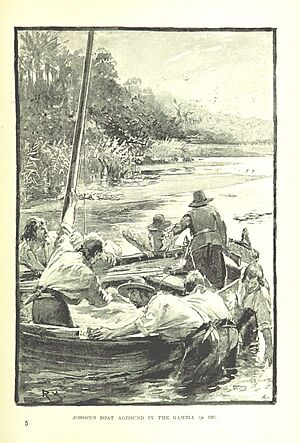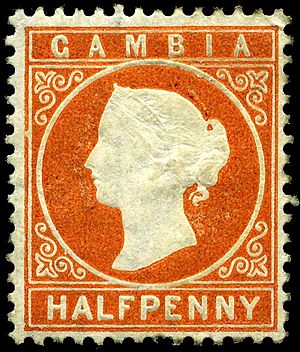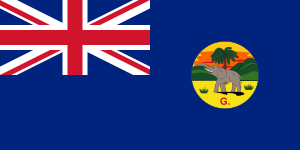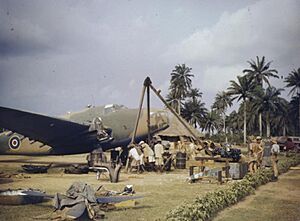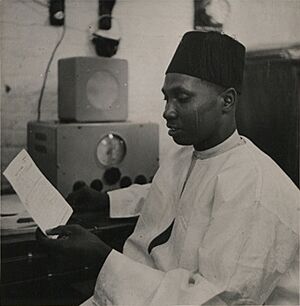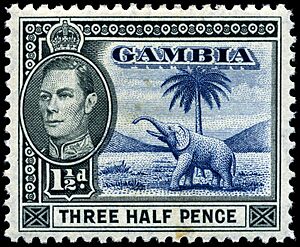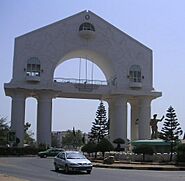History of the Gambia facts for kids
The history of The Gambia is a long and interesting journey, starting with ancient trade routes and powerful African empires. Later, European explorers and traders arrived, leading to a long period of colonial rule. This small country on the west coast of Africa eventually gained its independence and has since worked to build its own future.
The first written records about this region came from Arab traders in the 800s and 900s. In the Middle Ages, the area was a key part of the Trans-Saharan trade network. It was ruled by the mighty Mali Empire, known for its wealth and learning. Later, in the 1500s, the Songhai Empire took control.
The first Europeans to reach the Gambia River were the Portuguese in 1447. They tried to set up settlements, but none grew very large. Descendants of these Portuguese settlers lived there until the 1700s. In the late 1500s, English merchants also tried to trade with The Gambia. They heard it was "a river of secret trade and riches."
In the early 1600s, the French tried to settle in The Gambia but failed. English expeditions also faced many problems. In 1651, merchants from England sent ships, but they were captured. Around the same time, the Couronian colonization of The Gambia began. They built forts on islands, hoping to control the river. However, their rule was short-lived. In 1659, their lands were given to the Dutch West India Company. The Courlanders briefly got them back in 1660, but the next year, the new Royal African Company from England took over.
From 1677, England and France began a long struggle for control over The Gambia and Senegal. The French captured English lands several times. But in 1713, the Treaty of Utrecht officially recognized Britain's rights to the region. By the mid-1700s, the Royal African Company faced money problems. In 1750, the British Parliament took away their rights. In 1766, the British Crown took direct control, making The Gambia part of the Senegambia colony. This colony ended in 1783.
After Senegambia ended, the colony was mostly left alone. Only a few European traders remained in small settlements along the river. After the Napoleonic Wars, Alexander Grant was sent to restart a British presence. He founded Bathurst, and British lands grew through new agreements. The Gambia was managed from Sierra Leone until 1843, when it got its own Governor. It merged with Sierra Leone again in 1866. There were talks in the late 1800s about giving The Gambia to France, but people in both The Gambia and England strongly protested. In 1888, the colony got its own government again. By 1894, the Gambia Colony and Protectorate was fully set up.
In 1901, new councils were created for The Gambia. The Gambia Regiment was also formed. Gambian soldiers fought in World War I. In the 1920s, Edward Francis Small pushed for more rights, starting the Bathurst Trade Union. During World War II, the Gambia Regiment fought bravely in the Burma Campaign. In 1943, Franklin D. Roosevelt, the US President, visited The Gambia. This was the first time a US President visited Africa. After the war, changes sped up. The economy focused heavily on peanuts. The push for self-government grew, and the House of Representatives of the Gambia was created in 1960. Pierre Sarr N'Jie was Chief Minister from 1961 to 1962. Then, Dawda Jawara became Prime Minister, and his party, the People's Progressive Party, led Gambian politics for 30 years. The Gambia became fully self-governing in 1963 and gained independence in 1965.
The Gambia became a constitutional monarchy after independence, still part of the Commonwealth. But in 1970, it became a republic with a president. Jawara was elected the first President and stayed in power until 1994. A coup attempt in 1981 failed with help from Senegal. From 1981 to 1989, The Gambia was part of the Senegambia Confederation, which later broke apart. In 1994, Jawara was overthrown by Yahya Jammeh in a military coup. Jammeh ruled as a military leader for two years. He was elected president in 1996 and remained in power until 2017. During his rule, The Gambia left the Commonwealth of Nations in 2013. In the 2016 election, Adama Barrow was elected president. Jammeh refused to step down, leading to a crisis and military action by ECOWAS forces. Jammeh eventually left, and Barrow became president.
Contents
Early History of The Gambia
It's possible that the ancient Carthaginian explorer Hanno the Navigator sailed as far as The Gambia around 470 BC. We don't know much about the Gambia area before 500 AD.
Mali and Songhai Empires
The first reliable written accounts of the region come from Arab traders in the 800s and 900s AD. In medieval times, the area was very important for the trans-Saharan trade. The Mali Empire, famous for its Mandinka ruler Mansa Kankan Musa, became known worldwide for its great wealth and learning.
From the early 1200s, the Kouroukan Fouga, Mali's constitution, was the law of the land. The North African scholar and traveler Ibn Battuta visited the area in 1352. He said wonderful things about the people:
The people of the region possess many admirable qualities. They are seldom unjust and have a greater abhorrence of injustice than any other people. There is complete security in their country. Neither traveler nor inhabitant in it has anything to fear from robbers or men of violence.
The Songhai Empire took control of the region in the 1500s.
European Arrival in the 1400s and 1500s
By the 1400s, most of the Gambia valley was controlled by small Mandinka kingdoms. These were founded by people who had moved from the Mali Empire.
European exploration of The Gambia began in the 1400s. This was driven by the Portuguese Prince Henry the Navigator. In 1446, Portuguese captain Nuno Tristao made friends with people at Cape Vert. He signed a trade and friendship treaty with them. Each year, ships from Portugal came to trade. From these traders, Prince Henry learned about The Gambia. Reports said the river banks had lots of gold.
In 1455, Henry convinced a Venetian named Luiz de Cadamosto to search for the river. Later that year, he sent a Genoese trader, Antoniotto Usodimare, on the same mission. They met near Cape Verde and easily found the mouth of the Gambia River.
They reached the Gambia River in June 1455 and went a short way upstream. They repeated the trip in May 1456, going further upstream. They met some local chiefs. Near the river's mouth, they anchored at an island where a sailor had died and was buried. They named it St Andrew's Island after him.
The Portuguese tried to set up settlements on the river banks. But none grew very large. Many settlers married local people. They kept Portuguese clothes and customs, and said they were Christians. Communities of Portuguese descent lived in The Gambia until the 1700s. Churches existed in places like San Domingo in 1730. The name Gambia comes from the Portuguese word for trade, cambio.
After Spain took over the Portuguese throne in 1580, some Portuguese people fled to England. One of them, Francisco Ferreira, guided two English ships to The Gambia in 1587. They returned with valuable goods like hides and ivory. In 1588, António, Prior of Crato, who wanted to be King of Portugal, sold exclusive trading rights between the Senegal and Gambia Rivers to London merchants. Queen Elizabeth I confirmed this right for ten years. The merchants sent ships, but due to Portuguese hostility, they didn't go further south than Joal. They reported that The Gambia was "a river of secret trade and riches concealed by the Portuguese."
The 1600s: European Rivalries
English Exploration and Trade
In 1612, a French attempt to settle in The Gambia failed due to illness. Other English adventurers were given trading rights in 1598, 1618, and 1632. But the English didn't explore much until 1618. An expedition led by George Thomson aimed to open trade with Timbuktu. While he was away, his ship's crew was killed by the Portuguese. Thomson himself was later killed by one of his companions.
A rescue expedition arrived from England, led by Richard Jobson. He took some Portuguese ships in revenge. Jobson also went upriver and wrote positive reports about trade in The Gambia. During his trip, Jobson refused to buy slaves offered by an African merchant. He stated that "we were a people who did not deal in such commodities." However, both his and Thomson's expeditions lost a lot of money. After losing £5,000, the English stopped trying to trade in The Gambia for a while.
In 1651, the Commonwealth of England gave trading rights to London merchants. They sent two expeditions and set up a trading post at Bintang. Some members went as far as the Barakunda Falls looking for gold. But the climate was harsh. In 1652, Prince Rupert of the Rhine captured the merchants' ships. After this big loss, they gave up on The Gambia.
Courlander and English Control
Meanwhile, Jacob Kettler, the Duke of Courland, had gained control of St Andrew's Island and other lands in 1651. Courland sent settlers and built forts on St Andrew's Island and Banyon Point. This was part of Courland's efforts to colonize other places, like Tobago. The Courlanders believed they could control the river and charge tolls. They built a fort and placed cannons to guard the river. Their plan to sell slaves to Tobago didn't work out.
In 1658, Duke Kettler was captured during a war. Funds for The Gambia ran out. In 1659, Courland's lands in The Gambia were given to the Dutch West India Company.
In 1660, a French privateer captured the fort on St Andrew's Island. The Dutch then left the fort, and the Courlanders took it back. After the English monarchy was restored in 1660, England became interested in The Gambia again. This was because of rumors of a gold mine upriver. A new company, the Royal Adventurers in Africa Company, was formed. James, Duke of York, and Prince Rupert were important members.
At the end of 1660, the Adventurers sent an expedition to The Gambia led by Robert Holmes. Holmes arrived in early 1661. He took over Dog Island, renaming it Charles Island. On March 18, 1661, he sailed to St Andrew's Island and demanded the Courlanders surrender. There were only seven Europeans in the fort, so they had to give in. The next day, Holmes took the fort, renaming it James Fort after the Duke of York. The Dutch West India Company tried to take the fort in 1662 but failed. The English remained in control.
Control by Traders
The Duke of Courland protested the seizure of his lands. After talks, he gave up his claims to African lands to Charles II in 1664. In return, he got the island of Tobago and the right to trade personally in The Gambia.
From the mid-1600s, English, Dutch, French, and Baltic traders fought over trading rights from their bases at Fort James Island and Albreda.
In 1667, the Royal Adventurers rented their trading rights to another group, the Gambia Adventurers. This group only had the rights for a year. Then, the rights went back to the Royal African Company, which had bought the Royal Adventurers' property earlier.
In 1677, the French took the island of Gorée from the Dutch. This started a 150-year struggle between England and France for control in Senegal and The Gambia. By 1681, the French had a small area at Albreda, across from James Island. They kept this foothold until 1857, except for short periods when they had to leave due to local troubles or wars with England.
The 1700s: Wars and Changes
Trade Company Problems
During wars with France after the Glorious Revolution, James Fort was captured by the French four times: in 1695, 1702, 1704, and 1708. But France never tried to keep the fort permanently. In the Treaty of Utrecht in 1713, the French agreed that James Island and English settlements belonged to England.
These wars led to a rise in piracy along the West African coast. English trade in The Gambia suffered greatly from pirates. In 1719, a pirate named Howell Davis captured James Fort. In 1721, some soldiers at the fort rebelled and became pirates. Finally, in 1725, James Fort was badly damaged by an accidental gunpowder explosion.
After these events, the Royal African Company had 20 years of good trade. Trading posts were set up far up the river, and there was a lot of trade with inner Africa. However, despite yearly money from the British government to maintain their forts, the Royal African Company faced serious money problems. By 1749, James Island was in "miserable condition." In 1750, it was reported that the fort's soldiers had been reduced by sickness from 30 to only five to eight men. With all officers dead, a common soldier was in charge.
By 1750, the situation was critical. An Act of Parliament was passed. It took away the Royal African Company's rights and gave its forts to a new company controlled by merchants. This new company was not allowed to trade itself. It received yearly money to maintain the forts. This was meant to prevent one company from having too much control.
Senegambia Colony and Abandonment
In 1766, another Act of Parliament took the fort and settlements from this new company and gave them to the British Crown. For the next 18 years, The Gambia was part of the Senegambia colony. The main government was in St Louis, at the mouth of the Senegal River. A Lieutenant Governor was put in charge of James Fort and The Gambia settlements.
In 1779, the French captured James Fort for the fifth and final time. This time, they destroyed the fortifications so completely that they could not be rebuilt after the war. Except for a brief period after the Napoleonic Wars, James Island stopped being important in The Gambia's history.
In 1783, St Louis and Goree were given back to France. Senegambia stopped being a British colony.
The Gambia was then given back to the Royal African Company. But they didn't try to govern The Gambia. In 1785, Lemain Island was bought by the British government to set up a prison colony, but this plan never happened. For the next 30 years, British influence in The Gambia was limited to a few traders. These traders set up settlements along the river banks. Pisania was probably the most important of these. This settlement helped explorers like Mungo Park on their journeys into Africa.
The 1800s: British Return and Expansion
Early 1800s
At the start of the 1800s, most settlements on the Gambia River were British. To the north, there were several local kingdoms, including Barra and Woolli. These kingdoms traded a lot with the interior of Africa.
In 1807, the slave trade was made illegal by the British Parliament. At that time, the British controlled Goree. With help from the Royal Navy, the Goree soldiers tried to stop slave traders in the Gambia River. These traders were mostly Spanish and American. The slave traders often fought back, and the British soldiers suffered losses.
British Recolonization
After the Treaty of Paris in 1814, which ended the war with the French, British forces left the island of Gorée. Captain Alexander Grant was sent to see if Fort James could be rebuilt. But he decided that St Mary's Island would be better. Grant made a treaty with the King of Kombo on April 23, 1816, giving the island to the UK. He also founded the town of Bathurst on St Mary's Island.
In 1821, the Royal African Company was closed. The Gambia was placed under the control of the Governor of Sierra Leone. It was managed from Sierra Leone until 1843, when it became a separate colony. However, in 1866, The Gambia and Sierra Leone were again united under the same administration.
The British government continued to gain more land beyond St Mary's Island. They signed treaties with local chiefs. Lemain Island, 160 miles upriver, was given to the United Kingdom in 1823. It was renamed MacCarthy Island. Georgetown was set up there as a military base and home for freed slaves. In 1826, the Ceded Mile, a strip of land on the north bank of the river, was given by the King of Barra. Fattatenda was given in 1829. More land was gained later, including Albreda, the French area, in 1857.
Becoming a Colony
In the 1850s, the French colony of Senegal began to expand. It almost surrounded The Gambia. The French saw The Gambia as a possible trade route. Talks about giving The Gambia to France in exchange for other West African lands started in 1861. These talks were serious in 1865 and 1866, and again in 1870 and 1876.
However, the idea faced strong opposition in the British Parliament and among merchants in England. The local people in The Gambia also protested. Because of this strong opposition, the British government could not go ahead with the plan. In 1888, The Gambia was again separated from Sierra Leone. From then until its independence, it operated as a separate colony. In 1889, France and Britain agreed on the borders of The Gambia, Senegal, and Casamance.
During this time, despite some small wars with local groups, the Gambian government signed many treaties with chiefs along the river. Some treaties gave small areas of land to Britain. Most others placed areas under British protection. The last important treaty was in 1901 with Musa Molloh, a powerful chief. In 1894, a law was passed to better manage areas under British protection. It was decided that these places could not be managed from Bathurst. So, in 1895 and later years, laws were passed to bring these areas under the Protectorate's control. Finally, a 1902 law brought all of The Gambia, except St Mary's Island, under the Protectorate system.
The 1900s: Towards Independence
Early Years and World War I
The Gambia got its own executive and legislative councils in 1901. It slowly moved towards self-government. Also in 1901, the Gambia Company, the first colonial military unit, was formed. A 1906 law officially ended slavery.
During World War I, the Gambia Company fought alongside other British troops in the Kamerun campaign. Many soldiers received medals for their bravery.
In 1920, the National Congress of British West Africa was formed. This group worked for African freedom. Edward Francis Small was the only delegate from The Gambia. He returned and started the Gambia Section of the Congress. Its main goal was to get elected representatives in the Gambian government. It also often protested against unpopular government policies. Small had some success, founding the first Gambian trade union, the Bathurst Trade Union, in 1929.
World War II and Post-War Changes
During World War II, the Gambia Company became the Gambia Regiment. It had two battalions from 1941. It fought in the Burma Campaign. The Gambia itself was also important for the war effort. It had RAF Bathurst, a flying boat base, and RAF Yundum, an air force station. A British warship, HMS Gambia, was launched in 1942. Bathurst was also the closest English-speaking port to Dakar.
In 1943, Franklin D. Roosevelt, the President of the United States, stopped overnight in Bathurst. This was on his way to and from the Casablanca Conference. It was the first time a sitting US president visited Africa. The visit made him strongly dislike British colonial rule. He was shocked by the poverty and disease there, calling the territory a "hell-hole" to Winston Churchill.
After World War II, changes happened faster. The Gambian economy relied heavily on groundnuts (peanuts). They were almost the only export, making the economy weak. Attempts were made to grow other goods, like the Gambian poultry scheme. This aimed to produce millions of eggs and a lot of poultry. But conditions in The Gambia were not good, and disease killed many chickens.
The Gambia River was the main way to travel and transport goods inland. The main port was at Bathurst. Roads were mostly around Bathurst, with other areas connected by dirt roads. The only airport was at Yundum, built during World War II. After the war, it was used for passenger flights. The airport was rebuilt in 1963.
Steps Towards Self-Government
To prepare for independence, efforts were made to create internal self-government. The 1960 Constitution created a partly elected House of Representatives. It had 19 elected members and 8 chosen by chiefs. This constitution had problems in the 1960 elections. The two main parties tied with 8 seats each. With support from the unelected chiefs, Pierre Sarr N'Jie was appointed Chief Minister. Dawda Jawara resigned, leading to a new Constitutional Conference.
The conference led to a new constitution that gave more self-government and more elected members in the House of Representatives. Elections were held in 1962. Jawara's party won most of the elected seats. Under the new rules, Jawara became Prime Minister. He held this job until it was removed in 1970. After the 1962 elections, full internal self-governance was granted the next year.
Independent Gambia
At a conference in June 1964, British and Gambian leaders agreed that The Gambia would become independent on February 18, 1965. It was decided that Elizabeth II would remain the head of state. A Governor-General would act on her behalf. On February 18, Prince Edward, Duke of Kent, formally granted independence. Prime Minister Jawara represented The Gambia. It became the 21st independent member of the Commonwealth.
Soon after, the government held a vote to replace the Queen with an elected president as head of state. The vote did not get the two-thirds majority needed to change the constitution. But the results were praised internationally as proof of The Gambia's fair elections and civil rights.
Jawara's Time as President
On April 24, 1970, The Gambia became a republic within the Commonwealth. Prime Minister Sir Dawda Jawara became the head of state.
Jawara's time in power was mostly stable. But a coup attempt in 1981 broke this peace. The coup was led by Kukoi Sanyang. After a week of violence, Jawara, who was in London, asked Senegal for help. Senegalese troops defeated the rebels.
After the coup attempt, Senegal and The Gambia signed a treaty in 1982. The Senegambia Confederation was formed. It aimed to combine the two countries' armies and unite their economies. The Gambia left the confederation in 1989.
President Jawara led The Gambia until a military coup in July 1994. He had been re-elected five times.
Jammeh's Rule and Its End
In July 1994, Yahya Jammeh led a coup that removed Jawara's government. From 1994 to 1996, Jammeh ruled as head of the Armed Forces Provisional Ruling Council (AFPRC). He banned opposition political activity. The AFPRC announced a plan to return to civilian rule. They set up an election commission in 1996. After a vote on the constitution in August, presidential and parliamentary elections were held. Jammeh became president on November 6, 1996.
Jammeh won the elections in 2001 and 2006. He was re-elected as president in 2011. On October 2, 2013, The Gambia announced it would leave the Commonwealth of Nations. They said they would "never again be part of a neo-colonial organization."
In December 2014, there was an attempted coup to overthrow President Jammeh.
Fall of Jammeh and New Leadership
The presidential election of 2016 saw a surprising victory for the opposition candidate, Adama Barrow. He defeated Jammeh. However, Jammeh refused to accept the results and would not leave office. He declared a state of emergency. Barrow left the country and went to Senegal. He was sworn in as the new president at the Gambian embassy in Dakar on January 19, 2017.
On the same day, ECOWAS launched a military action to remove Jammeh from power. This was called Operation Restore Democracy. It was approved by the United Nations Security Council. On January 21, 2017, Jammeh announced he would step down and left the country for exile. On January 27, 2017, Barrow returned to The Gambia and officially took office.
Barrow's Presidency
On April 6, 2017, parliamentary elections were held. Barrow's United Democratic Party won most of the seats in the National Assembly.
The Gambia officially rejoined the Commonwealth on February 8, 2018.
On December 4, 2021, Gambian President Adama Barrow won re-election in the presidential election. Opposition candidates questioned the results.
Since Jammeh's removal, The Gambia has made big steps towards democracy. Recent elections have been seen as fair. Media freedom and freedom of speech have greatly improved. The courts have also become more fair and independent. To bring justice for past wrongs, the Truth, Reconciliation and Reparations Commission was set up in 2018. Barrow had initially promised to serve only three years. But he changed his mind and formed a new party. He also formed a government with the former ruling party, which caused protests.
See also
 In Spanish: Historia de Gambia para niños
In Spanish: Historia de Gambia para niños
- List of heads of government of The Gambia
- List of heads of state of The Gambia
- Politics of The Gambia
- Military history of The Gambia



